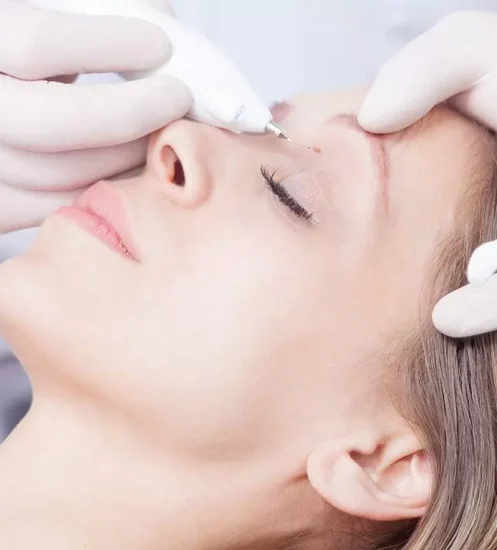Removal of Facial and Body Moles

The genetic traits and exposure to sunlight are significant elements in determining mole numbers. However, moles may merge in sun-protected areas too.
New moles occurring after 35 years of age may require a medical examination and possible biopsy. A newly-emerged mole in an adult might be a sign of early melanoma. It is vital that an experienced dermatologist tests every new or growing mole.
You should consult a doctor in these conditions
- If a change occurred in size, color, or shape by time.
- If the mole is asymmetric.
- If the mole’s shape is abnormal.
- If the mole’s diameter is larger than usual.
- If the mole is multicolored.

Face and body moles are divided into different types according to their levels and appearance.
New moles occurring after 35 years of age may require a medical examination and possible biopsy. A newly-emerged mole in an adult might just be a sign of early melanoma. It is vital that an experienced dermatologist tests every new or growing mole.
- Congenital Moles: Congenital moles are small moles on the skin since birth and are not harmful. It is possible to remove the big ones by the surgeon.
- Acquired Moles: This type of moles occurs after birth. They are generally not dangerous, but it is preferable to consult a doctor if any change happens in these moles.
- Birth Sign: Birth signs are light pink moles; it is rare to occur and might cause some itch.
- Atypical Moles: Atypical moles are different in color and shape from congenital moles. These moles are big and wide and contain many colors. Generally, these moles are suspicious because of their colors and shapes.
Operation Details
REMOVAL OF FACE AND BODY MOLES METHODS
Laser removal is usually recommended for non-cancerous or harmless moles. These moles can be flatter and lighter in color and are being removed for cosmetic reasons.
With the latest laser technology improvements, surgeons can penetrate deep enough into the skin and with enough power to remove moles without surgery. Laser Mole Removal uses light energy to break down the pigments within the mole. Laser mole removal is a good option for removing a mole from the face with less risk of scarring.
A quick visit to Natural Clinic can determine if you are a candidate for laser mole removal.
Some non-cancer moles may be shaved under local anesthesia for aesthetic purposes.
For the Shave Removal procedure, the surgeon uses a thin scalpel to carefully removes the mole. A device with a tiny electrode may be used to perform electrosurgical feathering at the end.The feathering helps minimize the excision appearance by blending the edges of the wound with the surrounding skin. Stitches are not needed after a shave excision. The patient may have a pink mark on your skin where the mole was, but this should fade over time.
The mole is usually examined under a microscope afterward to check for signs of skin cancer.
Surgical Removal is deeper than shave removal and more like traditional surgery.
The procedure is performed under local anesthesia and requires a small stitch in the skin afterward. Your dermatologist cuts out the entire mole and below to the subcutaneous fat layer and stitches, then the incision closed. The mole will be examined for cancer cells.
You should never try mole removal yourself. The risks of infection and scarring are too high. You may leave cancer cells behind if the mole was cancerous.
F.A.Q.
There may be a form of scarring caused by the healing process when the skin is cut.
Yes. Since there are no specific sun restrictions after the surgery, people may go out with sunscreen and protective hats and clothing.
No, there are no blood tests or specific X-rays for moles. Yet, the latest digital mole imaging technologies are now available to evaluate moles.
Yes. In some cases, moles may lighten or completely disappear later in life. In some instances, this results from the body’s immune system attacking the mole and causing it to regress.
Most people report none or minimal discomfort after mole-removal surgery and require no pain medication. If there is pain, prescription pain medications may be necessary.
Being one of the top destinations for medical tourism, Turkey has a booming, cost-effective, and high-end health and medical services industry. Completed with internationally accredited surgeons and experts with celebrity level reputations, a reliable infrastructure, and very affordable prices of Turkey’s health and medical services industry quickly offers very high-end services, high standards with very cost-competitive prices.
Yes. While many moles arise in the first years of life, the total number of moles typically peaks in the second or third decade of life to 35.
Yes. Moles may be present at birth or gradually emerge later.









